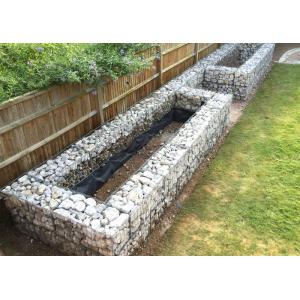
Add to Cart
Gabion retaining wall gabions / landscape gabion wall design
Gabion walls made from stone filling and the mesh cages, which were joined together with metal clips, with small rocks. the exterior facade is made of cement sheet with the gabions forming a cosmetic face at the front. Gabions also create thermal mass and have a secondary insulating function.
Welded mesh gabions Originally used for retaining slopes, rock gabion walls have been cropping up everywhere from garden walls, planters and benches, to the walls of outdoor rooms. The gabion wall will into your landscape.
Gabion retainning wall applications:
1. Tiered planting. Functioning both as retaining walls for the gentle slope and as an architectural feature of the landscape.
2. Modern bench seating.Tucking rock cages underneath benches is another great way, The gabions add textural contrast in what would otherwise be a landscape of many smooth surfaces, including concrete and decomposed granite.
3. Integrated with nature. The gabion walls — used as a facing in front of solid walls — were filled with stones gathered from the property mixed with gravel sourced nearby. The stones also help regulate the building’s temperature, absorbing heat from the sun during the day and keeping the interior cool while radiating stored heat at night.
4. Art backdrop. Gabion baskets can be infilled different materials, It's better to match the surrounding landscape, it's more and more liked by designers.
5. Indoor-outdoor accent wall. Just as a wall of exposed brick can really make a room inside the house, a texture-rich gabion wall can take the design of an outdoor room up a notch as well.
6. Retaining wall. The original use of gabion walls — to retain slopes — remains highly effective in landscapes. The wall could be softened further by tucking succulents or other low-water plants into the crevices between the stones.
| Length (m) | Width (m) | Height (m) | Spacer number | Volume (m2) | Tolerance range |
| 2.0 | 1.0 | 0.15---0.3 | 1 | 0.3~0.6 | Length :±/-3% Width :±/-5% Height :±/-5% |
| 3.0 | 1.0 | 0.15---0.3 | 2 | 0.45~0.9 | |
| 4.0 | 1.0 | 0.15---0.3 | 3 | 0.6~1.2 | |
| 2.0 | 1.0 | 0.5 | 1 | 1.0 | |
| 3.0 | 1.0 | 0.5 | 2 | 1.5 | |
| 4.0 | 1.0 | 0.5 | 3 | 2.0 | |
| 1.0 | 1.0 | 1.0 | 0 | 1.0 | |
| 1.5 | 1.0 | 1.0 | 0 | 1.5 | |
| 2.0 | 1.0 | 1.0 | 1 | 2.0 | |
| 3.0 | 1.0 | 1.0 | 2 | 3.0 | |
| 4.0 | 1.0 | 1.0 | 3 | 4.0 |
Note: Gabion walls are easier to climb than smooth stone walls or other forms of perimeter fencing. If security is a concern in your neighborhood, or your county has regulations against fences or walls that can be climbed, a gabion may not be the right choice for a perimeter wall.
